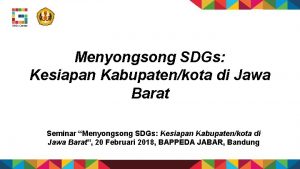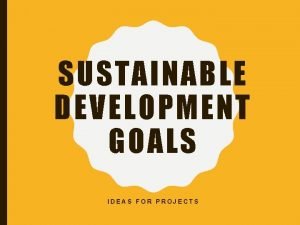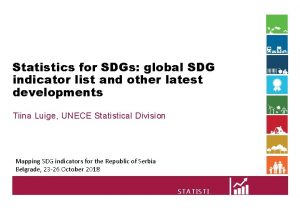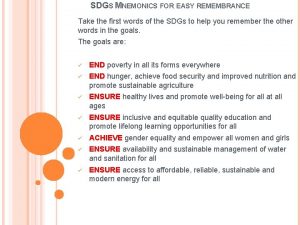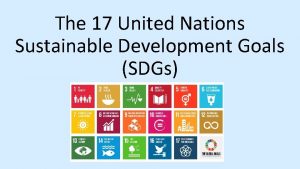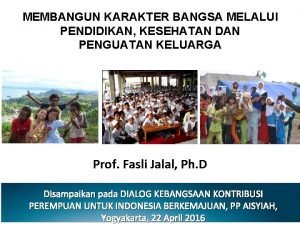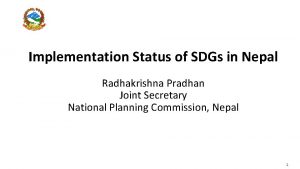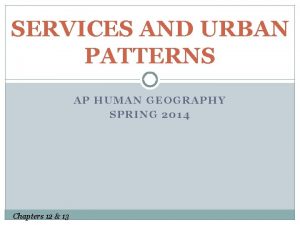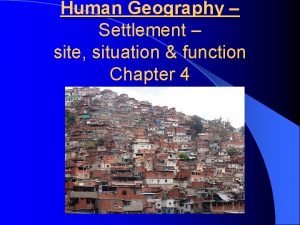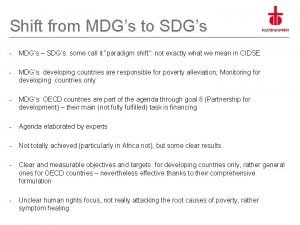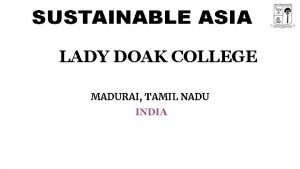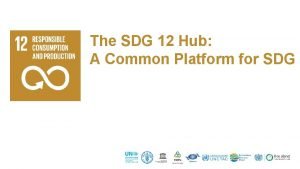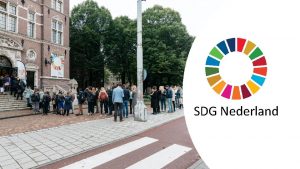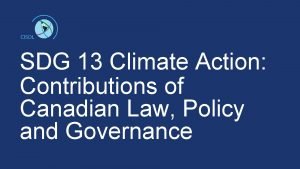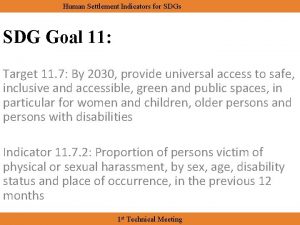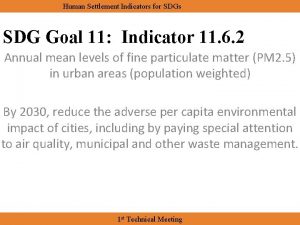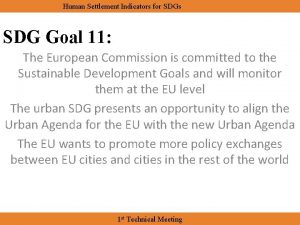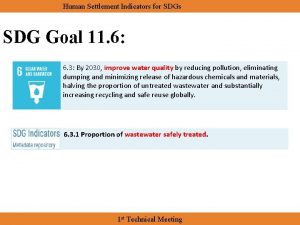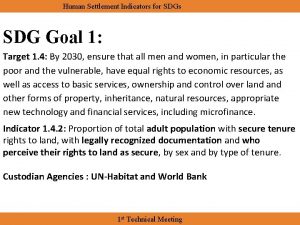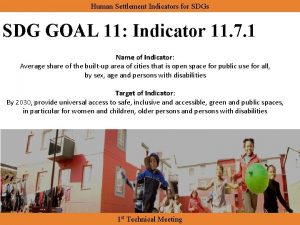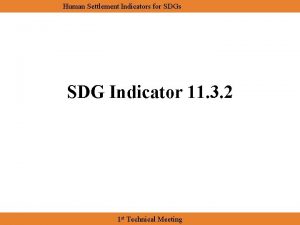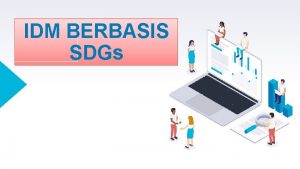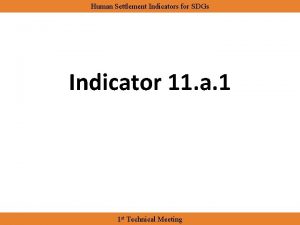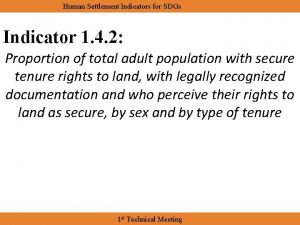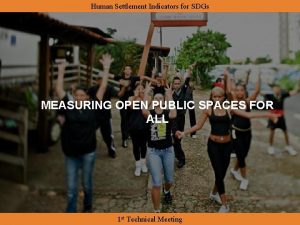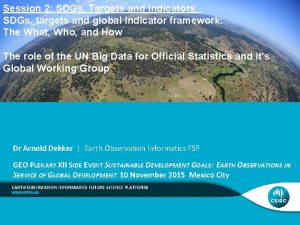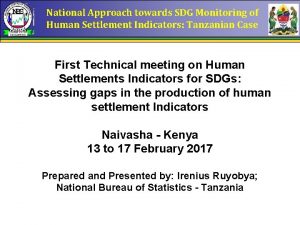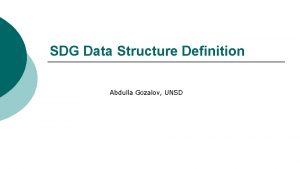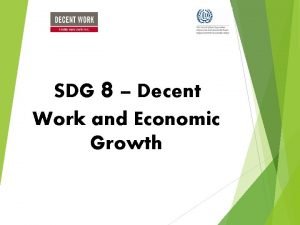Human Settlement Indicators for SDGs SDG Goal 11


















- Slides: 18

Human Settlement Indicators for SDGs SDG Goal 11. 6: 11. 6 By 2030, reduce the adverse per capita environmental impact of cities, including by paying special attention to air quality and municipal and other waste management. 11. 6. 1 % of urban solid waste regularly collected and with adequate final discharge with regards to the total waste generated by the city 1 st Technical Meeting

Human Settlement Indicators for SDGs Status of the Indicator: Tier 2: Indicator conceptually clear, established methodology and standards available but data are not regularly produced by countries. Timeframe: 2017 - Consultation with experts on monitoring framework and methodology - Testing methodology and data collection 2018 - Continued testing methodology and data collection - Proposal of indicator revision and reporting 2019 - Adoption of indicator revision - Start of global monitoring together with CD for national and local governments 1 st Technical Meeting

Human Settlement Indicators for SDGs Ongoing Work: • Indicator refinement • Identification of existing data collection system in the United Nations • First Expert Group Meeting inviting key academics and practitioners was held January 26 • Proposal on sub-indicators • Strengthening partnership with experts and stakeholders 1 st Technical Meeting

Human Settlement Indicators for SDGs Ongoing Work: Existing Data UN-Habitat’s Urban Indicators Guidelines Agenda Goal 11: “Reduce Urban Pollution” Indicator 3. 6: solid waste disposal Percentage of solid waste: • disposed to sanitary landfill; • incinerated and burned openly; • disposed to open dump; • recycled; and • other. Indicator 3. 7: regular solid waste collection Proportion of households enjoying weekly solid waste collection 1 st Technical Meeting

Human Settlement Indicators for SDGs Ongoing Work: Existing Data UN-Habitat (2010) Status of Solid Waste Management in the World Cities 1 st Technical Meeting

Human Settlement Indicators for SDGs Ongoing Work: Existing Data UN-Habitat (2010) Status of Solid Waste Management in the World Cities 1 st Technical Meeting

Human Settlement Indicators for SDGs Ongoing Work: Existing Data UNSD/UNEP Questionnaire on environment statistics Waste R 1: Generation of Waste by Source R 2: Management of Hazardous Waste R 3: Management of Municipal Waste R 4: Composition of Municipal Waste R 5: Management of Municipal Waste – City Data R 6: Supplementary information sheet 1999 2001 2004 2006 2008 2010 2013 Total responses 49 62 68 78 83 83 81 Non-responses 119 115 90 85 88 89 92 29 35 43 48 49 48 47 168 177 158 163 171 172 173 Response rate (%) Countries that received the Questionnaire http: //unstats. un. org/unsd/environment/questionnaire. htm 1 st Technical Meeting

Human Settlement Indicators for SDGs Definition: Urban Waste There is no internationally agreed definition of “urban waste” Whether or not include sewage sludge and faecal sludge in the monitoring scope? Whether or not include the following? - Waste from healthcare facilities Industrial waste Agricultural waste Mining waste Construction and demolition waste End of life vehicles and WEEE (Waste Electrical and Electronic Equipment) Should we stick to “municipal waste” as a monitoring scope as it has internationally agreed definition theoretically and practically? 1 st Technical Meeting

Human Settlement Indicators for SDGs Urban Waste: EGM Results • • • Many participants responded that the faecal sludge and sewage sludge should be excluded from the monitoring scope by the indicator. Likewise many expressed that the monitoring scope should focus on ‘municipal solid waste’ because this has clear and internationally agreed definition both theoretically and practically. Although some argued WEEE (Waste Electrical and Electronic Equipment) should be included otherwise cannot be captured and monitored, UNEP Basel Convention Secretariat stated this is already addressed by Basel Convention. Monitoring scope should be ‘municipal solid waste’ rather than ‘urban solid waste’. → This means the phrase in target ‘municipal and other ‘waste’ should be changed to ‘municipal solid waste’ → Also the indicator should be rephrased as ‘municipal waste’ 1 st Technical Meeting

Human Settlement Indicators for SDGs Definition: Adequate Discharge Current Definition: Waste that is recycled in regulated recycling facilities, composted or incinerated in regulated composting and incineration facilities and disposed in sanitary landfills in environmentally adequate ways. It excludes waste handled in recycling, composting, incineration facilities that do not have necessary pollution control systems and labour safety standards required by international guidelines or national and local legislations such as waste water treatment and air pollution prevention systems and provision of necessary equipment for workers. It also excludes solid waste that is incinerated and burned openly or disposed to open dump without leachate facility. 1 st Technical Meeting

Human Settlement Indicators for SDGs Adequate Discharge: EGM Results • Most of the participants agreed that current definition cannot capture the gradual improvement that usually occur in the solid waste management system. With the current definition, the values in most of the developing countries will be 0%. This discourages the decision makers to put efforts in achieving SDG 11. 6. • Also many agreed ‘discharge’ is a terminology in the waste water treatment area, hence should be changed to ‘adequate treatment and disposal’. • Some indicated environmental adequateness should be looked at from the perspective of ‘environmental effect’ rather than focusing on specific technology. • Terminology should be ‘adequate treatment and disposal’ • Definition should be changed to be able to capture the gradual improvement of solid waste management. • ‘Environmental adequacy’ should be defined by the effect to the environment 1 st Technical Meeting

Human Settlement Indicators for SDGs Gradual Improvement Example Stepwise progression controlling disposal UN-Habitat (2010) Status of Solid Waste Management in the World Cities 1 st Technical Meeting

Human Settlement Indicators for SDGs Joint monitoring is essential!! Methodology: 1 2 3 Public health waste collection Waste Collection Coverage: % households who have access to a reliable waste collection service Environmental control disposal Controlled treatment or disposal: % of the total municipal solid waste destined for treatment or disposal which goes to either a state-of-the-art, engineered or ‘controlled’ treatment / disposal site Resource value - ‘ 3 Rs’ Reduce, reuse, recycle Recycling rate: % of total municipal solid waste generated that is recycled. Includes materials recycling and organics valorisation (composting, animal feed, anaerobic digestion). Extract from guidance notes in User Manual Waste collection coverage represents the access that the population of a city have to a waste collection service, including both formal municipal and informal sector services. A ‘collection service’ may be ‘door to door’ or by deposit into a community container. ‘Collection’ includes collection for recycling as well as for treatment and disposal (so includes e. g. collection of recyclables by itinerant waste buyers). ‘Reliable’ means regular - frequency will depend on local conditions and on any pre-separation of the waste. The ‘numerator’ in this calculation is the total waste that is dealt with in a ‘controlled’ facility (e. g for land disposal, composting or waste to energy). The ‘denominator’ is the total solid waste destined for treatment or disposal - that is the total waste generated less waste recycled or reused. Waste being accepted at a facility ‘counts’ towards this quantitative indicator if the facility has reached at least an intermediate level of control. To use land disposal as an example, and referring to the stepwise improvement of sites, both uncontrolled and semi-controlled sites would fall below the threshold, while controlled, engineered and full sanitary landfills would all count towards this indicator. Includes materials recycling and organics valorisation (composting, animal feed, anaerobic digestion). Includes the contribution from the ‘informal’ recycling sector as well as formal recycling as part of the solid waste management system. The total quantity collected for recycling should be adjusted downwards to allow for any materials that are subsequently rejected and sent for treatment or disposal. 1 st Technical Meeting 12. 5 scope Indicator name and definition 11. 6. 1 scope WASTEAWARE Indicators (Wilson et al, 2015)

Human Settlement Indicators for SDGs Merit of Wasteaware Indicators • Designing the SDG indicator 11. 6. 1 to be disaggregated into sub-indicators would allow visualisation of gradual improvement in solid waste management particularly in developing countries. • The first two of these sub-indicators could be provided by the Wasteaware benchmark indicators 1 (collection coverage) and 2 (controlled treatment or disposal). • The Global Waste Management Outlook (2015) used the Wasteaware indicators for 39 cities to point out the huge progress that many developing countries have made in the last 10 -15 years in improving collection coverage and controlled disposal rates. • The Wasteaware user manual provides detailed guidance on definitions used and criteria for judging ‘environmental appropriateness’. • A third sub-indicator will be required, being the proportion of waste going to controlled treatment or disposal which meets the threshold for ‘sustainable and environmentally sound management’. 1 st Technical Meeting

Human Settlement Indicators for SDGs Challenges experienced : • Data completeness and data quality remain a challenge (in particular for developing countries). • Estimation of ‘uncollected waste’ could be a challenge in terms of quality. • National capacity constraints (financial, human, technical) continue to be a concern for many countries. • There still remains inadequate institutional set-up. • Data collection and validation should be done at municipal/city level. • There should be regular contact with cities to ensure consistency of interpretation of methodology. • Larger investment is needed for capacity development for both national and local government officials in charge of waste management. 1 st Technical Meeting

Human Settlement Indicators for SDGs Challenges experienced : UN-Habitat Strong interlinkages between different indicators and need for joint monitoring Goal 11: Make cities and human settlements inclusive, safe, resilient and sustainable Targets 11. 6 Indicator By 2030, reduce the adverse per capita environmental impact of cities, including by paying special attention to air quality and municipal and other waste management. % of urban solid waste regularly collected and with adequate final discharge with regards to the total waste generated by the city Goal 12: Ensure sustainable consumption and production patterns UNEP Targets Indicator 12. 4 By 2020, achieve the environmentally sound management of chemicals and all wastes throughout their life cycle, in accordance with agreed international frameworks, and significantly reduce their release to air, water and soil in order to minimize their adverse impacts on human health and the environment. Treatment of waste, generation of hazardous waste, hazardous waste management, by type of treatment 12. 5 By 2030, substantially reduce waste generation through prevention, reduction, recycling and reuse. National recycling rate, tons of material recycled Goal 14. Conserve and sustainably use the oceans, seas and marine resources for sustainable development By 2025, prevent and significantly reduce marine pollution of all kinds, in particular from landbased activities, including marine debris and nutrient pollution 1 st Technical Meeting 14. 1. 1 Index of coastal eutrophication and floating plastic debris density

Human Settlement Indicators for SDGs Opportunities to be explored: Bilateral donors Waste management technology provider (private sector) Financial and technical support International Solid Waste Association Partnership for Joint Monitoring 11. 6. 1 (municipal waste) e (Hazardous waste) 12. 4 12. 5 (National recycling rate) 14. 1 (Marine litter) Capacity Development Nat. and Loc. Gvts Ownership (line ministries and NSOs) UNSD Environmental Coordination Statistics Coordination Data validation Local university Network (regular local contact (line ministries and NSOs) and data validation) 1 st Technical Meeting

Human Settlement Indicators for SDGs Best way forward: 2017 -2019 • Establishing monitoring framework and inter-agency partnership and fund raising • Testing the monitoring methodology in sample cities • Starting data collection and validation on municipal solid waste • Preparation of indicator revision proposal 2020 -2023 • Official revision of indicator • Identifying national focal points • Capacity development for national and local government officials • Support national level reporting 2023 -2030 • Further improve the monitoring method • Encourage systematic national recording • Data analysis and programme development/investment promotion to achieve waste SDG based on the data analysis 1 st Technical Meeting
 Sdgs jawa barat
Sdgs jawa barat Sdg projects ideas
Sdg projects ideas Sdgs list
Sdgs list Mnemonic for sdgs
Mnemonic for sdgs Https://sustainabledevelopment.un.org/sdgs
Https://sustainabledevelopment.un.org/sdgs Pilar lingkungan sdgs
Pilar lingkungan sdgs Sdgs 2030
Sdgs 2030 Elina bardram
Elina bardram Sdgs
Sdgs Sdgs
Sdgs Urban system definition ap human geography
Urban system definition ap human geography Settlement patterns
Settlement patterns Metes and bounds aphg
Metes and bounds aphg Why shift from mdg to sdg
Why shift from mdg to sdg Sdg 11
Sdg 11 Sdg 12 hub
Sdg 12 hub Sdg nederland
Sdg nederland Sdg compass ejemplos
Sdg compass ejemplos Sdg
Sdg
